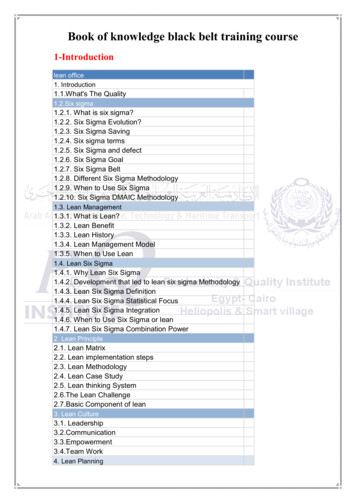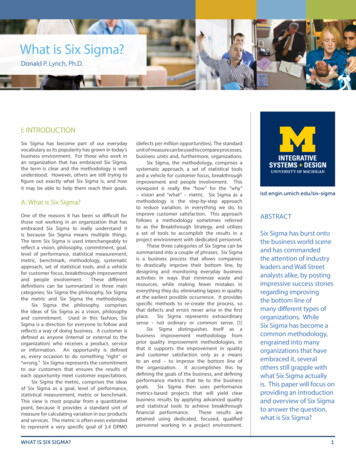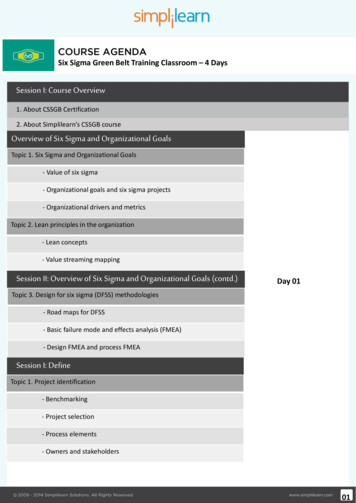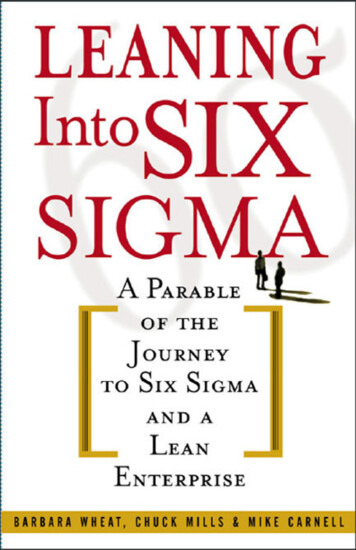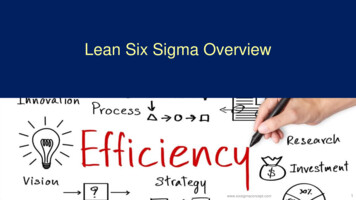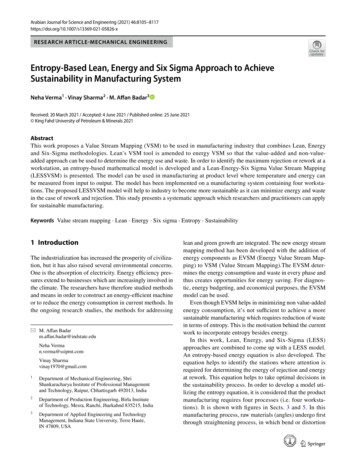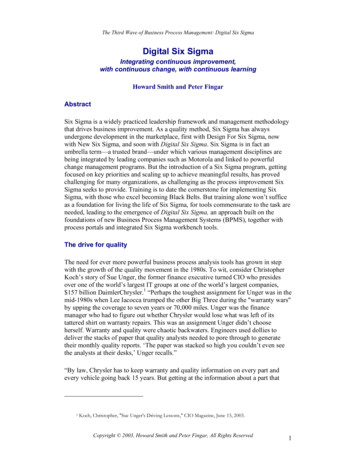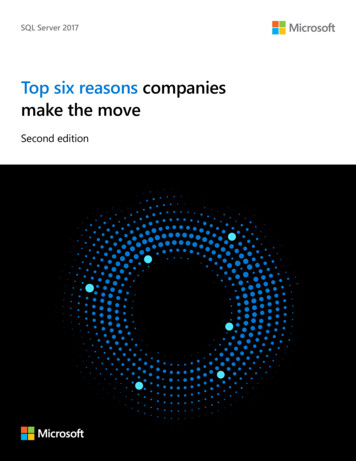
Transcription
SQL Server 2017Top six reasons companiesmake the moveSecond edition1
Table of Contents3IntroductionFive businesses, five storiesWhy they made the move6FlexibilityAny language, any platform, any cloudWork the way you wantInteroperability you can rely on8PerformanceQuicker queries mean time and money savedAnalytics and transaction processing, simultaneouslyEfficiency at its best11SecuritySecure at rest and in motionProtection that’s centrally managed12CostDon’t pay for more than you have toGet your investment back faster14Simplicity15Everything built in16Ease of migrationAn unmatched TCO with all the features you needSummary 2018 Microsoft Corporation. All rights reserved. This document is provided “as-is.” Information and views expressed in this document, including URL and other Internet Website references, may change without notice. You bear the risk of using it. This document does not provide you with any legal rights to any intellectual property in any Microsoftproduct. You may copy and use this document for your internal, reference purposes. You may modify this document for your internal, reference purposes.2
IntroductionAll data has a story to tell. Whether it’s customerbehavior or traffic patterns, bird migrations orbusiness growth, you need the skills and the toolsto gather the right information and pull the relevantpoints out of your data. That’s where the story lives.Five businesses, five storiesIn this case, we have the experiences of five verydifferent businesses—financial data analytics, ITconsulting, software services, cybersecurity, anddata warehouse automation—all with the goal ofefficiently managing and manipulating their data tomaximize value.Convergent Computing is a strategy and technologyconsulting firm that has provided innovativetechnology solutions, round-the-clock technicalsupport, and comprehensive personalized consultingfor more than 30 years. Recently, the companyneeded a way to move second-tier data processing tolower-cost hardware.dv01 was established in 2014 to provide datamanagement, reporting, and analytics insightsto lending markets. As the complexity of dv01’splatform increased, it began to run slower, with somequeries even timing out. The company realized it hadto address scalability and performance.3
As one of the world’s largest ergonomics consultingfirms, Humantech was trying to standardize its ITenvironment as part of a strategic transition from inperson consultancy to a software-as-a-service (SaaS)delivery model. But the company needed a solutionthat could accommodate its preferred Windowsdatabase, Microsoft SQL Server, and its production anddevelopment environments, which ran on Linux.International cybersecurity firm Binary Confidencefocuses on remote security monitoring, threat analysis,and incident response. As the volume of data anddevices it monitored grew, the company looked for adatabase that could scale as well as integrate easily withits existing open-source software.Australian startup Ajilius provides a cloud-native datawarehouse automation solution that runs on bothWindows and Linux. Facing challenges with systemavailability, upgrades, and performance with PostgreSQL,the company searched for a solution that would readilyconnect with business intelligence (BI) tools and allowit to create environments with higher requirements forsecurity, availability, and disaster recovery, without theadded complexity and cost of third-party tools.Spoiler alert: These companies all found what they werelooking for.4
Why theymade the moveDespite these companies’ distinct missions and goals, they all saw thepotential benefits of Microsoft SQL Server 2017 in one or more of thefollowing six areas, particularly when factoring in its availability on a newplatform choice, Everything built inRead on to hear perspectives from these businesses, sourced throughinterviews and testimonials directly from each company’s leadership, andsee how your own data ecosystem could benefit from SQL Server 2017.5
FlexibilityIn every story, there’s an element of choice: A or B, true or false, to beor not to be. Working with data is the same. Do you want your data ona public cloud, a private cloud, or on premises? Which language shouldyou use to write your applications? What platform do you want to runthose apps on?SQL Server 2017 saves you from difficult choices that can constrain yourproductivity, giving you the flexibility to use the language of your choice,on the platform of your choice, on premises or in the cloud.Any language, any platform,any cloudAs a company evolves, a specific technology stack can become bakedinto its DNA. This was certainly the case for data management firm dv01.As the company’s VP of Engineering Dean Chen says, “Our engineerscame from an open-source background and we’re an open-source shop.”This made trying SQL Server 2017 on Linux for many of the company’scritical workloads a natural choice. Once dv01 leadership saw that theupdated SQL Server platform outperformed previous solutions andcompetitive platforms, the decision to adopt was easy.Because SQL Server 2017 runs on Windows, Linux, and Docker containers,you can deploy on the platform—or combination of platforms—thatmakes the most sense for your business. And whether your engineersare more comfortable with C#, Java, Ruby, or another coding language,they can build apps using the best language and platform for the job andthen host the apps on any cloud provider or on-premises server that suitstheir needs.Work the way you wantCybersecurity company Binary Confidence uses a wide range oftechnologies based on both Linux and Windows to provide multiplelayers of support to its customers. Plus, the business works with data inmultiple formats on a diverse array of devices. The core analytics andreporting platform includes OSSEC, an open-source intrusion-detectionsystem that collects log data for storage and analysis in Elastic Stack anda relational database.6
One of the benefits that we had working withSQL Server 2017 is that we didn’t have toexport data from one database platform toanother that required the data to be certified;we actually had the database certified. Themigration was easy in that we went from oneplatform to the other without having to gothrough a lot of technical stuff.Rand MorimotoPresident, Convergent Computing7
The flexibility of SQL Server 2017 enabled Binary Confidence to switchfrom Windows to Linux Ubuntu, and ultimately install SQL Server 2017on Linux. The result? The new database works seamlessly with theheterogeneous environment. “SQL Server 2017 integrates really wellwith these open-source technologies,” explains Peter Kleinert, SolutionArchitect. “With our early database, we’d often deal with incompatibilitiesand badly written articles describing how to make things work together.Honestly, with Microsoft’s tools, everything just works.”Binary Confidence typically performs development work on WindowsServer 2012 R2 and Windows Server 2016 and runs its productionenvironment on Linux. “I love that SQL Server runs the same on Windowsor Linux,” says Kleinert. “It’s great because I have the flexibility to chooseeither platform, and it’s easier to integrate into our specific environment.”Interoperability you can rely onPerhaps, like many companies, you take advantage of multiple platforms.Fortunately, SQL Server 2017 supports that, too.With SQL Server 2017, your data can migrate from one platform toanother with minimal downtime using distributed availability groupsspanning both Windows and Linux environments. If you have issues withone deployment, you can use Always On availability groups to performmigrations across Windows and Linux or fail over between platforms toavoid downtime.
PerformanceWhen working with data, the technology you’re using should helpyou with the task, not get in the way. That’s why any loss of queryperformance can be a huge headache. And the ability of your analystsand engineers to query data quickly can give your business thecompetitive edge.Speed is important everywhere, but especially in the world of managingfinancial data. At dv01, VP of Engineering Dean Chen says, “We have afew queries that are really expensive and because these queries aretypically longer-running in nature, any speed improvement makes a huge,huge difference.” That’s one big reason dv01 decided to go with SQLServer 2017 on Linux.Binary Confidence noticed performance improvements for itscybersecurity services during a proof of concept (PoC), even beforethe company had done any optimization. Using SQL Server MigrationAssistant, the company was able to move data over with the sameindexes and reduce its database size by roughly half via pagecompression. It achieved its first benchmark in about a day and a half.“The magnitude of speed-up was staggering. The problematic queriesran 10 times faster, and the worst ones ran almost 500 times faster.And this was a PoC with no optimization,” says Solution Architect PeterKleinert. Promising initial results like these made the decision to moveforward an easy one.With a full implementation of SQL Server 2017, Binary Confidence usedbuilt-in features like SQL Server Profiler to quickly boost performanceand optimize index design and selection. Better parallel processing alsohelped the company run large queries more quickly on existing hardware.“With MariaDB, it didn’t matter how many cores I assigned, it wouldonly use three at most,” says Kleinert. “We’d have to break them downinto smaller queries to run in parallel. With SQL Server 2017, we can runa large single query without any changes and use all the cores on themachine.”For ergonomic consultant Humantech and its 100,000 users, performanceis critical to growing the company while maintaining its customerexperience. Ken Lupo, Humantech’s Director of Technology, cites as oneexample the ability to comprehensively manage server security from onecentralized view. “We have decreased our logging and monitoring timeby 50 percent because we’ve consolidated logging and messaging intoa single process,” he says. Lupo also appreciates the faster processing ofterabyte-scale data sets. “We observed a 22 percent time savings rightout of the gate.”9
SQL Server’s flexibility around being able to defineboth types of indexes really made the difference here.We were also hitting some limitations around thesize of our data and constantly having to upsize ourservers, and in SQL Server’s case the query wouldachieve a double or triple space savings, possibly more.Rand MorimotoPresident, Convergent ComputingQuicker queries meantime and money savedA number of high-performance features are included with SQL Server 2017(and available with Linux-based deployments). Among them is columnstore,which provides column-based data storage and processing to achieve upto 10 times the query performance and data compression over row-basedstorage. Yet another is in-memory online transaction processing (OLTP),which brings transaction processing to memory-optimized tables that can beup to 30 times faster than the speed of disk-based tables. With in-memorycolumnstore, queries can execute up to 100 times faster than disk. All ofwhich increases the speed of your data-driven applications.Data warehousing startup Ajilius uses columnstore in SQL Server as part of itsautomation solution to accelerate queries on its demo and training databases.“There’s no equivalent to SQL Server columnstore,” explains Ron Dunn, AjiliiusLead Developer. “Particularly with dimensional data warehouses, columnstoresignificantly speeds up queries. And by using compression, we can managemore data with less disk, which also benefits I/O. We’ve seen one of our testcases improve performance by more than 40 percent over PostgreSQL, andstar schema disk usage shrink to less than half,” he says.10
Ajilius employees now have more time for development and customersupport because system upgrades are easier and faster. “If I want to upgradeSQL Server on Linux, I have to type maybe 30 characters at a console,and everything happens automatically,” Dunn says. “It could not be moresimple. We’ve already done three upgrades and we’ve had zero problems.The operational and developer maturity of the product is substantial.” Thispredictability translates into greater efficiency and less trepidation. “Justknowing that an upgrade is going to work means that I can plan on havinganother six hours that same day for product development,” he notes.But the most obviousperformance gain is withlarge analytic queries,which range from2 to 500times faster.With clients across the world, Binary Confidence uses built-in capabilitieslike page and backup compression to improve efficiency and increaseperformance. “Log collection is faster, and my rough guess is that we’recutting the time in half—most likely because of page compression and betterindex management,” says Solution Architect Peter Kleinert. “But the mostobvious performance gain is with large analytic queries, which range from 2to 500 times faster.”Binary Confidence is also exploring columnstore indexes, which Kleinertexpects will make queries even faster. In addition, the company plans to takeadvantage of SQL Server 2017 for machine learning. With faster, in-databaseanalytics and machine learning, the company can enhance log analysis andits anomaly-detection system.Analytics and transactionprocessing, simultaneouslyAnalytics data is typically stored in a data warehouse or data mart that isdedicated to running analytics queries. However, that can introduce severalchallenges, including complexity, cost, and data latency. With real-timeoperational analytics, you can eliminate the need for ETL (Extract, Transform,Load) and a data warehouse.Real-time analytics uses an updateable columnstore index on a rowstoretable. The columnstore index maintains a copy of the data, so the OLTP andanalytics workloads run against separate copies of the data. This minimizesthe performance impact of both workloads running at the same time.Since analytics is a cornerstone of its business, this is a big advantage fordv01. “It’s a pretty special use case, being able to do these analytics queriesin real-time,” says Dean Chen, the company’s VP of Engineering. “That’stypically reserved for the realm of Hadoop or big-data infrastructuresthat have a lot higher latency. Microsoft was really helpful as part of thatprocess, and it’s one of those things that fit our use case really well.”11
With SQL Server 2017, we don’t have toconstantly take care of the database andoptimize queries and hardware. Instead,we can spend much more time developingour applications.Peter KleinertSolution Architect, Binary ConfidenceEfficiency at its bestFinally, adaptive query processing is available to further improve queryperformance. Adaptive query processing not only designs the queryexecution plan and then executes it in the most efficient way, it optimizesthe plan while the actual query is running—or even after the queryexecution is completed to benefit later executions. Additionally, queryprocessing is getting smarter all the time. Improvements to adaptivequery processing in SQL Server 2017 include batch mode memory grantfeedback, batch mode adaptive joins, and interleaved execution.National Institute of Standards and Technology ComprehensiveVulnerability Database as of January 17, 2017.112
SecurityFew things are more important to data than how secure it is. If yourbusiness relies heavily on data, and that data is vulnerable, it putsthe entire enterprise is at risk—potentially including your customers,partners, and employees. Establishing your business on a foundation ofhigh-quality, reliable data means trusting that it can’t be tampered with,wherever it lives.As the security landscape has changed over the years, Microsoft hascontinued to change with it. With a philosophy of engineering securityfrom the ground up and building in layers of protection, SQL Serverstands out with the fewest vulnerabilities of any enterprise database inthe National Institute of Standards and Technology (NIST) database overthe last seven years.In particular, SQL Server 2017 on Linux gives Ajilius the confidence toaddress the security needs of its customers. “I was just talking to a Linuxcustomer who was deeply concerned about the potential visibility ofcredit card details in his warehouse,” says Ron Dunn, Lead Developer. “Byusing SQL Server on Linux, he can address those concerns. Its seamlessintegration with Active Directory, row-level security, and transparentdatabase encryption provide significant advantages over other databaseplatforms in dealing with personally identifiable information.”Secure at rest and in motionLarge amounts of data lead to plenty of complexity. Data is queried,transmitted, backed up, and replicated nearly constantly. With all thatactivity, any link in the chain could be a potential vulnerability.That’s why Always Encrypted is critical to protecting your sensitive datastored in SQL Server databases. Always Encrypted enables encryption ofsensitive data inside applications and on the wire, while never revealingthe encryption keys to the database engine. As a result, Always Encryptedprovides a separation between those who own the data and those whomanage the data. And Row-Level Security adds another layer of accesscontrol by restricting permissions to rows in a database table based oncharacteristics of the user executing a query.Protection that’s centrally managedTo make security features even easier to manage in SQL Server 2017,you can use Active Directory authentication to centralize the identitiesof database users and other services in one location. This way, you cansimplify permission management and avoid storing passwords.13
With SQL Server, security is just so wellintegrated—it’s literally something you turnon, and data is encrypted on disk. It’s alsoencrypted in memory, which is pretty big. Butthe main thing for me is all of that just camefree; it was just a flip of the switch and it wassuper well-integrated.Peter KleinertSolution Architect, Binary Confidence14
CostBeyond the complex tasks of building and maintaining databases, you’reprobably also concerned about the shifting costs of data. If queriestake more time than they need to, that increases the hours spenttroubleshooting by your developers and administrators. And as your dataneeds scale up, it becomes more expensive to store all that information.Fortunately, SQL Server 2017 on Linux offers a potentially wallet-savingsolution, where everything is built in from the start.“That’s where Linux has played in some of our other models,” says RandMorimoto of IT consultancy Convergent Computing. “I can basically doa lot of our work on lower-cost hardware.” He’s also quick to emphasizethat the benefit is more than just financial. It’s also performance-based:“It’s about what can I put on Linux that will decrease my marginalcost and provide me with the same or equivalent performance, if notpotentially better performance.”Don’t pay for more than you have toFrom additional hardware and software licenses to training and thesheer amount of time required, deploying and maintaining databasescan get expensive quickly. But SQL Server offers ways to reduce thosecosts, or possibly avoid them altogether, as happened for Convergent.“Using SQL Server Management Studio to manage both Linux andWindows environments means we don’t have to retrain people orcertify people on a new platform,” says Rich Dorfman, VP of ProfessionalServices at Convergent.For Binary Confidence, the impact on its cybersecurity business hasbeen significant. In the face of doubling or tripling the number ofconnected devices each year, and an annual quadrupling of data, thecompany expects to cut its storage costs at least in half thanks to pagecompression. “Scalability isn’t a problem either,” says Peter Kleinert,Solution Architect. “We run SQL Server 2017 on a virtualized machinewith just 12 cores and 16 GB RAM. We could increase the resources, butthere is just no need to do so.”Following its implementation of SQL Server 2017 on Linux, Humantechsaw immediate gains in efficiency. “Right off the bat, we saw a 50percent reduction in overall support and maintenance costs,” says KenLupo, Director of Technology. “Plus, by not choosing a traditional Linuxdatabase, we saved three to six months of learning curve, and we feltthat we gained strong security and reliability.”15
Our normal return on investment for any ofthe hardware has typically been about twoand a half years. With this current model,we’re able to get a return on investment inless than eight and a half months.Rand MoritomoPresident, Convergent Computing16
The long-term administration and supportcosts are higher with other platforms. We alsoreduced our hosting expenses by more than30 percent by moving to SQL Server on Linux.Peter KleinertSolution Architect, Binary ConfidenceAs Humantech’s President Jim Good points out, that sort of time savingstranslates to the bottom line as well. “We’re talking about a race torevenue. That three to six months would have been a big cost and astrategic loss,” he says.Get your investment back fasterOf course, your databases and the data that’s within them are critical.But that doesn’t mean that you should need to break the bank to workwith your data. With SQL Server 2017 on Linux, it’s possible to realize alower total cost of ownership (TCO) and fast return on investment (ROI).Avoiding extra licenses, training time, and hardware costs will ensure yourinitial investment in SQL Server pays off.17
SimplicityThe explosion of data over the past few decades dramatically shifted howwe store, analyze, manipulate, and secure information. Databases anddatasets can be infinitely complex, but working with data shouldn’t bedifficult. That’s why SQL Server 2017 aims to simplify data managementfor you and your engineers.Ease of migrationAlthough Windows and Linux are significantly different operatingsystems, the experience of migrating data from one platform to theother isn’t as complicated of a process as it might seem. Convergentexperienced this firsthand when it migrated three internal applications,including the corporate intranet.“Moving SQL Server from Windows to Linux was actually one of theeasiest migration experiences that we’ve had,” says Chris Amaris,Convergent’s Chief Technology Officer and Project Technical Lead. “Wetook the SQL Server Windows database offline, encrypted it, and movedit across to the new Linux environment with certain keys. When webrought the database up in the new environment, we certified that thekeys matched, to confirm the data had not been tampered with.”Rand Morimoto, President at Convergent, confirms, “Because we weremoving the SQL Server database from one operating system to another,rather than porting data from one database platform to another, wedidn’t have to have the data completely recertified,” he says. “Weonly had to show that the database transferred unmodified, whichsaved us from a very lengthy and costly compliance audit, review, andrecertification.”Because the migration process is made simpler, there isn’t the need foradvanced customizations or third-party solutions, enabling engineers torefocus their work on higher-value tasks.18
When it comes to just migrating ourinfrastructure over, it was literally plugand play, and that’s how it ended upworking out.Dean ChenVP of Engineering, dv0119
Everythingbuilt inWith database management systems, it’s no small undertaking to meetthe mission-critical needs of modern enterprises. Features that used tobe optional are now frequently required by organizations to meet newstandards of security, functionality, and usability. Achieving missioncritical readiness by adding options and feature packs can drive up costsquickly. That’s why SQL Server 2017 on Linux builds in everything youneed from the get-go.An unmatched TCO with all thefeatures you needBy including everything you need to manage your data and keep itsecure, SQL Server helps keep your management costs down. Becauseeverything works “out of the box” when you get started, you saveengineering hours not having to set up custom solutions or buy thirdparty add-ons.As Peter Kleinert of Binary Confidence relates, “SQL Server 2017 iseasier to develop, optimize, and run than MariaDB and MySQL. I spenta lot of time trying to make this or that work well, and we’d have to getadditional tools if we needed more capabilities. With the SQL Serverecosystem, I haven’t had this problem.”A key factor in reducing your TCO is the inclusion of enterpriselevel features with SQL Server, which for comparable databaseplatforms are either available at an additional cost or simply notavailable, necessitating a third-party solution. With features like datacompression, columnstore, partitioning, high availability, and disasterrecovery included, your organization can provide robust, data-drivenapplications to customers for a fraction of the cost of the competition.As Scott Guthrie, Executive Vice President, Cloud Enterprise Group atMicrosoft, shared, “SQL Server on Linux will provide customers witheven more flexibility in their data solution, one with mission-criticalperformance, industry-leading TCO, best-in-class security, and hybridcloud innovations—all built in.”20
With SQL Server on Linux, we gain a worldclass database product running in theenvironment we want. We’re no longerlimited by the underlying operating system.For us, that is a breath of fresh air.Ken LupoDirector of Technology, HumantechWith SQL Server, things just came ‘outof the box’—it worked; it was superpolished. We didn’t waste much timetrading stuff out.”Dean ChenVP of Engineering, dv0121
SQL Server on Linux cuts your costs. It’s simpleto install and administer. And if you have aLinux-focused development team, which moststartups do these days, it’s a great productbecause it guarantees compatibility with moretarget customers.Ron DunnLead Developer, Ajilius22
SummaryThe data landscape is always changing, so it can be challengingto keep up and do so in a way that makes the most sense foryour business. The right database platform can be a future-prooffoundation on which you can build the applications and tools yourbusiness needs to succeed. Is your data ecosystem holding you back,or driving your business forward?Get started with SQL Server2017 on Linux today23
dv01 was established in 2014 to provide data management, reporting, and analytics insights . connect with business intelligence (BI) tools and allow it to create environments with higher requirements for security, availability, and disaster recovery, without the . SQL Server 2017

